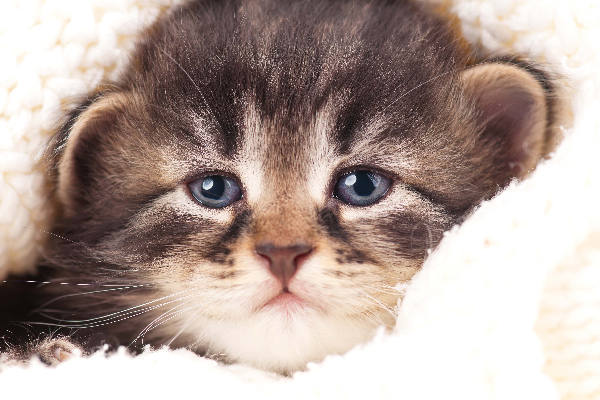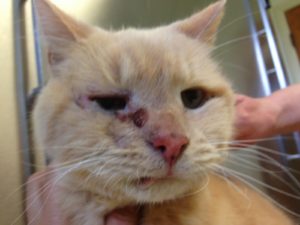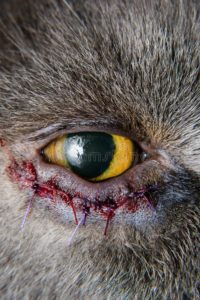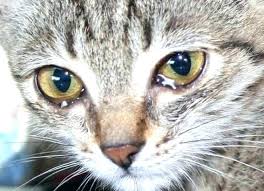Excessive Tearing in Cats

Veterinarians usually divide epiphora, or excessive tearing, into two categories — excessive tear production or inadequate tear drainage.
Similar to our own eyes, a cat’s eyes will tear after being exposed to irritants like chemicals and dust, smoke and smog. When the irritant in question either subsides or disappears, so should the cat’s increased tearing. If, however, the irritant persists, her excessive tearing may become chronic. (Infections, allergies and various types of eye injuries can also result in epiphora).
Another common cause of excessive tearing is entropion, a genetic condition in which part of a cat’s eyelid (usually the lower lid) is folded in towards her eyeball. This scratches and irritates her cornea rather than protecting it, and because the cornea is rich with pain receptors, it not only causes persistent tearing but extreme discomfort.
Applying artificial tears or a vet-prescribed ointment to the affected cornea may soothe the eye, forming a barrier between the eye and the offending lid, but it’s only a temporary solution. The permanent solution is surgical, where a thin V-wedge of skin below the affected eye is removed and the edges sutured together. This allows the eyelid to roll back outward and away from the cornea, giving the cat some much-needed relief from pain.
Corneal ulcers (scratches or abrasions to the corneal surface) are another cause of epiphora. Such ulcers are quite painful and result not only in redness but squinting and tearing, prompting a cat to constantly swipe or rub at the affected eye. If left untreated, a corneal ulcer will only grow worse, and if it’s deep enough, the eye could rupture and the cat could lose her sight in that eye.
The second category in the epiphora equation is inadequate tear drainage. Normally, tears drain from a cat’s eyes into her nose and throat through small ducts located at the inner corners of her eyes. Sometimes, though, her tears can’t drain sufficiently because the openings of those ducts are blocked.
One possible reason: eye inflammation as the result of a severe respiratory infection that caused scarring at the opening of one or both of her tear ducts. Another possible reason: one or both ducts that didn’t properly open during her early development. To correct this condition surgically, the cat will be anesthetized by a vet and a thin tube called a cannula will be inserted into one or both of her tear ducts to unblock them.
In short, if the underlying cause of epiphora can be identified and treated: problem solved. Brachycephalic cats (flat-faced breeds like Himalayans and Persians), on the other hand, with their large eyes, shallow eye sockets and abnormal tear ducts, are predisposed to epiphora. Since their tears simply slide down their faces, they’re likely to spend their “exotic” lives with watery eyes and wet faces.
And because tears contain a small amount of pigment, the fur of light-colored cats tends to show some reddish-brown staining beneath their eyes. Although this staining is harmless, many owners find it both undesirable and ugly. For these owners, there are a variety of products available that are specifically formulated to help minimize those stains. But, as with all things cat, concerned owners should always consult their vets first to ensure these products are FDA approved and safe.



